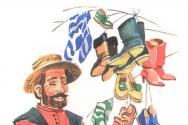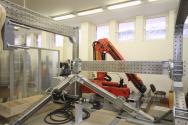Eyelash worms are representatives of the name. Class ciliated worms or turbellaria. General characteristics of the type
Eyelash wormsExternal structure of ciliated worms
Dimensions eyelash worms most often fluctuate within a few millimeters, less often centimeters, among them there are a lot of small forms, the dimensions of which do not exceed 1-2 mm. However, among turbellarians there are also larger worms. Thus, the Baikal worm Polycotylus reaches 30 cm, and some terrestrial tropical forms have a length of 50-60 cm.
The body of turbellarians in most cases is flattened in the dorsoventral direction, leaf-shaped, however, among the small species, some have a more or less fusiform shape.
Most turbellarians do not have any appendages on their bodies. Only some have two outgrowths in the form of small tentacles at the head end. The movements of turbellarians are varied. They are caused, on the one hand, by the movement of the cilia covering the body of the turbellaria, and on the other, by the contraction of the muscles.
Skin-muscle bag
 Eyelash worms
Eyelash worms Body surface ciliated worms are covered with single-layer ciliated ciliated epithelium. Underneath it are located numerous unicellular (less often multicellular) mucous, adhesive and protein glands, the ducts of which open outwards among the epithelial cells. Mucous glands secrete mucus that facilitates the gliding of turbellaria. The secretions of the adhesive glands harden in the form of threads, on which animals can temporarily hang on the surface film of water or underwater objects. Protein glands form a poisonous secretion that has a protective value.
Many epithelial cells contain so-called rhabdites. These are highly refracting light rods located inside cells. They represent the “formed secret” of cells. Rhabdits are formed directly in epithelial cells or in cells located deeper - in the parenchyma. The latter are connected to epithelial cells by cytoplasmic bridges along which rhabdites move to the surface.
At the slightest irritation, rhabdites are thrown out of the cells and spread into a mucous mass. They consist of toxic substances and represent a means of defense and attack. In any case, it is known that many eyelash worms are inedible to other animals.
Under the skin epithelium, separated from it by a thin basal membrane, muscle fibers are located in layers. Directly under the epithelium there is a continuous circular, or transverse, layer of muscle fibers. This layer is so called because the axes of the muscle cells are located transverse to the axis of the worm's body. The contraction of these muscles causes compression of the body. Under the annular layer there is usually a layer of so-called oblique, or diagonal, muscles. The axes of the muscle fibers that make up this layer are located perpendicular to each other and at an angle to the annular layer. Finally, the third layer consists of muscle fibers stretched along the animal's body. This is a layer of longitudinal muscle fibers. All muscle layers are composed of smooth muscle fibers. The muscles, together with the skin epithelium, form a musculocutaneous sac, which is very characteristic not only of flatworms, but also of other types of worms, although the number of muscle layers and their sequence may be different.
In addition to the muscles that make up the skin-muscle sac, they also have bundles of muscles stretching from the dorsal part of the skin-muscle sac to the abdominal. These are dorsoventral muscle bundles. The totality of all the described muscles determines all the rather complex movements of the turbellarian body.
Parenchyma
As already noted, inside the skin-muscle sac, the entire space between the various organs is filled with parenchyma, consisting mainly of loosely arranged cells of indeterminate shape; often these cells are equipped with processes, with intercellular substance between them.
Parenchyma is loose connective tissue of mesodermic origin. Among the main cells of the parenchyma are numerous muscle fibers, glandular cells, rhabditis cells, etc.
Digestive system
In turbellaria, like in coelenterates and ctenophores, the digestive system is closed, i.e., the mouth is the only opening through which food is absorbed and its “undigested remains - excrement” are thrown out. Most turbellaria are characterized by the division of the intestine into two sections: the anterior ectodermic pharynx and the middle cecum-closed endoderm. The mouth is always located on the ventral side, but may be closer to the anterior or posterior end, and sometimes may be located in the center of the ventral surface.
In some turbellarians, the pharynx may be absent or have the form of a short simple tube, they have no midgut at all, and the digestive cells are located in the parenchyma, without forming a digestive cavity. Such a very simple structure of the digestive organs is characteristic of lower turbellarians, mainly living in the seas and united in the order Acoela.
In all other ciliated worms (turbellarians), the pharynx is well developed, and most often it is a tube with very muscular walls, placed in a special vagina, from which the pharynx can protrude outward. This pharynx is a catching or sucking apparatus.
The midgut can have a different structure. In some turbellarians, the pharynx leads to a sac-shaped midgut that does not have any branches. This occurs in small turbellarians.
In large turbellarians, the intestine is more or less highly branched; branches extend from the sac-like part of the intestine: one forward to the head and many paired branches going in all directions. These intestinal outgrowths, in turn, branch out. This intestinal structure is observed in marine turbellarians belonging to the order Polycladida. The branching of the midgut and the radial arrangement of its branches in multibranched animals gave rise to comparison of the midgut of these turbellarians with the gastrovascular system of the coelenterates.
Finally, turbellarians from the suborder Tricladida do not have a main intestine and three branches of the midgut extend directly from the pharynx. One branch goes forward to the head, and two are directed to the posterior end of the body. All these branches of the intestine, in turn, branch. Many freshwater turbellarians belong to this suborder.
The degree of branching of the intestines of various turbellarians is undoubtedly related to the size of the animals. Apart from the intestinal ones, the smallest among the turbellarians will be the forms with an unbranched intestine.
The intestine reaches the greatest degree of branching in larger ones - multibranched and tribranched turbellarians. This is explained by the absence of a circulatory system in turbellaria. The midgut is not only a digestive organ, but also functions to distribute food throughout the body, similar to the gastrovascular system of jellyfish and ctenophores. The walls of the midgut are lined with single-layer epithelium, consisting of cells with rounded, widened ends, among which are located special glandular cells. These cells secrete digestive enzymes into the intestinal cavity. However, food digestion in the intestinal cavity occurs only partially. Small food particles are captured by intestinal epithelial cells and digested within these cells.
Thus, with regard to the digestion process, turbellarians differ little from coelenterates. The cells of the midgut have a phagocytic function, and digestion in turbellarians is also largely intracellular.
Turbellaria, like all flatworms, do not have an anus or hindgut. However, some turbellarians have special pores through which the intestinal cavity communicates with the external environment. The meaning of these pores is not clear.
Excretory system
Excretory organs first appear in ciliated worms. They are represented by a system of highly branched canals, often forming bridges or anastomoses. The thinnest tubules are closed blindly by end, or terminal, cells, and the main channels are opened by excretory openings. The terminal cells are pear-shaped, often with stellate processes, and are located directly in the parenchyma. Inside the cells there is a cavity in which a bunch of long cilia is placed. The bundle of cilia is in a continuous oscillatory motion, reminiscent of the vibrations of a candle flame, for which these cells are called flame cells. The cavity of the terminal cell continues in its process. This is the beginning of the excretory canal. Further, a number of elongated cells adjoin the cell process, through which the channel passes. The tubules extending from nearby flame cells connect into larger ducts, then these ducts flow into even larger ones that open with one or more openings to the outside.
The described organs secrete excess water from the body, as well as liquid dissimilation products. The decay products of organic substances diffusely penetrate from the parenchyma into the cavity of the excretory cell and, with the movement of a flickering flame, are driven through the channels, which are also lined with cilia, and are finally released out.
The most important feature of the excretory organs of ciliated worms (and all flatworms) is the presence of special terminal cells that close the excretory canals. This type of excretory organ of invertebrates is called protonephridia.
In different turbellarians, the excretory organs are developed differently. They are less developed in marine forms (multibranched and intestinal turbellaria), probably because, living in salt waters, the body is not overloaded with water.
Nervous system
In some of the most primitive ciliated worms from the order of intestinal worms, the nervous system is a diffuse nerve plexus; a denser cluster of nerve cells is located at the anterior end of the body, forming a rudimentary head ganglion, from which nerve trunks extend almost radially.
In multibranched ciliated worms, the brain ganglion is located close to the center of the body (in rounded forms) or shifted to the anterior end (in elongated forms). Up to 11 pairs of nerve trunks diverge radially from it, connected by transverse bridges, or commissures. Usually the posterior pair of nerve trunks is the most developed. As a result, a fairly regular nerve network is formed, especially clearly expressed in forms with a centrally located nerve ganglion.
Sense organs of ciliated worms, eyes
The sense organs are represented primarily by tactile cells, especially numerous at the anterior end and sides of the body. The head tentacles of some ciliated worms or turbellarians serve as organs of chemical sense.
In many turbellarians (intestinal, some Catenulida, Seriata, etc.), in close connection with the head ganglion there is a statocyst, in the form of a closed vesicle with a statolith inside. Statocyst organ of orientation of an animal in space. When the position of the worm's body changes, the signal from the statocyst is transmitted through the nervous system to the muscles of the turbellaria until the latter assumes a normal position.
Most turbellarians have one or more pairs of eyes (some terrestrial planarians have more than 1000) of a different structure than the eyes of jellyfish already known to us. The eyes are located directly under the skin epithelium and consist of a pigment cup and optic cells. The pigment cup, most often consisting of one giant cell, has the shape of a bowl, with its concave part facing the periphery. The cell (or cells, if the glass is multicellular) is filled with pigment, and the nucleus is placed in its convex part. One or more visual cells of a peculiar, club-shaped shape are immersed in the pigment cup. The extended ends of these cells end in light-sensitive rods or cones. The curved parts of the visual cells face the surface of the body, and the nerves of the cephalic ganglion approach them. Thanks to this arrangement of cells, light rays first pass through the plasma of the visual cell, and then hit the light-sensitive part of the cell. (In other animals, the photosensitive part of the cell faces directly to the light.) Therefore, eyes of a structure similar to those of turbellarians are called reversed or inverted.
Reproduction
The vast majority of eyelash worms are hermaphrodites. The genital organs of ciliated worms are extremely complex and diverse in different groups. They differ in the number of gonads, their structure, and the presence of many additional formations of the reproductive system. Thus, the male sex glands - the testes - can be large single or paired or small numerous formations. The female gonads - the ovaries - are usually paired, but can be single or numerous. More primitive turbellarians have simple ovaries. Eggs are formed in them, which contain a certain amount of yolk, as well as shell substance. Such eggs are called entolecithal. In more highly organized turbellarians, the ovaries are differentiated into sections: one of them, large, produces only nutritious yolk cells, and the other, small, produces eggs. These sections can turn into independent paired organs: the ovaries themselves and the vitelline sacs. The resulting eggs are completely devoid of yolk. After fertilization, they are surrounded by yolk cells, and then a common membrane is formed around them. Such eggs are called ectolecithal.
The ducts of the gonads - the vas deferens and the oviducts - are usually paired, in the lower section they merge into unpaired formations. They can open independently into the male and female genital openings on the ventral side of the body or into the common genital cloaca.
Lower turbellarians lack female excretory ducts. Thus, some intestinal ciliated worms do not have oviducts. The sperm is introduced by the partner, who breaks through the integument of the worm with the copulatory organ. The sperm enters the parenchyma and fertilizes the eggs located there. Oviposition is possible through a rupture in the body walls or through the mouth, as in coelenterates.
Let us examine the complex structure of the hermaphroditic reproductive system of ciliated worms using the example of the milk planaria (Dendrocoelum lacteum), common in fresh waters.
The male genital organs consist of numerous small testes located in the parenchyma on the sides of the entire body. The thinnest seminiferous tubules extend from the testes, which flow into two vas deferens that go backward. Behind the pharynx, the vas deferens empty into the seminal sac. In the posterior part, the seminal sac passes into the copulatory organ, penetrated by the ejaculatory duct. During copulation, the copulatory organ extends through the genital cloaca and is inserted into the genital opening of another individual.
The female reproductive apparatus most often consists of one pair of ovaries located in the front of the body. Two long oviducts depart from the ovaries, running backward along the sides of the body and merging into an unpaired oviduct, which opens into the genital cloaca next to the pouch of the copulatory organ.
Along the entire length of the paired oviducts, the ducts of numerous vitelline cells open in them, in which special vitelline cells rich in nutritional materials are formed.
Two more organs open into the genital cloaca: the copulatory bursa, a folded sac with a rather thin stalk-like canal, and a muscular glandular organ. Its meaning is not clear.
When mating planarians, the copulatory organ is inserted into the genital opening and through the genital cloaca into the copulatory bursa of the other individual. Thus, sperm first of all enters the copulatory sac, and from it into the oviducts, into that part of them that is located near the ovaries. Fertilization occurs when eggs are released from the ovary into the oviduct. Then the eggs, moving along the oviducts past the openings of the vitelline ducts, are surrounded by yolk cells and enter the reproductive cloaca. Here, around the eggs, together with the yolk cells, a cocoon is formed from the secretions of the yolk cells and special shell glands. The deposited cocoon is suspended from underwater objects.
Development
In ciliated worms with entholecithal eggs, complete uneven fragmentation occurs in a spiral type, reminiscent of the fragmentation of eggs of annelids, nemerteans and mollusks.
The development of turbellarians is usually direct, only in some groups metamorphosis is observed. In marine multibranched ciliated worms, a peculiar ovoid-shaped Müllerian larva emerges from the egg. At first it reveals features of radial symmetry, and then increasingly acquires bilateral symmetry. In front of the mouth, located on the ventral side, there are 8 lobed outgrowths covered with cilia. Such a larva leads a planktonic lifestyle, and this ensures the dispersal of marine turbellarians. Larvae of marine turbellaria are transported by sea currents over long distances and gradually develop into adult animals. At the same time, their mouth moves forward, the perioral lobes become smaller, and the whole body is flattened. The larva sinks to the bottom and finally acquires bilateral symmetry.
The development of ectolecithal eggs occurs differently. In the milk planaria described above, the cocoon contains from 20 to 40 eggs and about 80-90 thousand yolk cells. The latter surround each egg and later merge to form a syncytium. The blastomeres are separated and immersed in the total mass of the yolk. They form three groups of cells, two of which ensure the absorption of the yolk by the embryo, and the third forms the embryo itself. Development is direct: small planaria hatch from the cocoon.
Asexual reproduction is observed in some turbellarians from the orders Macrostomida, Catenulida and Seriata (suborder Tricladida). It involves the transverse division of worms. In some forms, for example in Microstomum lineare, asexual reproduction occurs throughout the summer and is replaced by sexual reproduction only in the fall. During asexual reproduction, a constriction appears in the middle of the body, and the formation of a mouth and pharynx begins at the rear half. Long before the worm divides into two, the daughter individuals also begin to divide and constrictions of II, III, etc. orders appear. This forms a chain of dividing zooids.
Gallery

They live in salty and fresh waters; some species have adapted to life in humid terrestrial habitats. Representatives of other classes lead an exclusively parasitic lifestyle, parasitizing various animals, both vertebrates and invertebrates.
Encyclopedic YouTube
1 / 5
✪ Flatworms
✪ Flatworms. Online preparation for the Unified State Exam in Biology.
✪ Biology 7th grade. Type flatworms
✪ 6 Type Flatworms - structure (7th grade) - biology, preparation for the Unified State Exam and the Unified State Exam 2018
✪ Type Flatworms Class Ciliated worms | Biology 7th grade #12 | Info lesson
Subtitles
Anatomy and physiology
general characteristics
The space between the skin and internal organs is filled with mesenchyme - connective tissue reinforced with collagen fibers, which act as skeletal elements and muscle attachment points. Oxygen, nutrients and metabolic products that enter it from internal organs move through the mesenchyme by simple diffusion. Mesenchyme consists of two types of cells: main cells, which contain many vacuoles, and stem cells, which can turn into any other cell types. Stem cells provide damage healing and regeneration during asexual reproduction.
Appearance
Veils
The body wall is a skin-muscular sac. The skin-muscle sac consists of a single-layer epithelium and three layers of smooth muscles: circular, oblique and longitudinal. Flukes and tapeworms have a surface layer called tugument, while ciliated worms have cilia.
Parenchyma
Fills the gaps between organs, performs a supporting function and serves as a depot of nutrients.
Musculature
It is represented by three layers of smooth muscles: oblique, circular and longitudinal.
Nervous system
It is represented by paired nodes (ganglia) and longitudinal trunks extending from them, which are connected by annular bridges. This type of nervous system is called stem (orthogonal).
Sense organs
Digestive system
Excretory system
Excretory system of protonephridial type. Protonephridia is a system of tubules that begins in the parenchyma with a cell with a bunch of cilia and ends with the common excretory duct.
Internal transport
Reproductive system
Locomotion
Free-living turbellarians can move in a variety of ways. Some glide along the surface of the bottom (or other substrate) or swim using cilia located on the surface of the body. Others may use muscles for the same purpose. A wide range of movements can be observed in different turbellarians. Their body can contract or extend, they can bend their body at a large angle, turn in all directions, and make undulating movements. Peristaltic waves run through the body of some of them. The mechanism of locomotion mainly correlates with body weight - smaller tubellaria often use only the movement of cilia (peristalsis, if observed, is intended for the digestion process), and larger ones use the muscles of the body. In some groups, the ventral surface of the body forms a specialized organ for locomotion, which is carried out by its contraction. Some large turbellarians (Polycladida) carry out forward movement by dorsoventral undulation of the lateral edges of the body.
Unlike free-living turbellarians, Neodermata endoparasites have limited locomotion abilities, manifested mainly in those phases of the life cycle in which the parasite needs to leave the previous host and find and then infect a new one. Trematodes, for example, have a ciliated epidermis at the miracidium stage, which helps the larva swim freely in the water before meeting its gastropod host. At a later stage of trematode development, cercariae, these forms have a muscular tail, allowing them to swim in search of the next host (which is a vertebrate animal). Aspidogastra have one larval stage, which contains a ciliated swimming larva
a brief description of
|
Habitat and appearance |
Dimensions 10-15 mm, leaf-shaped, live in ponds and low-flowing reservoirs |
|
Body cover and skin-muscle bag |
The body is covered with single-layer (ciliated) epithelium. The superficial muscle layer is circular, the inner layer is longitudinal and diagonal. There are dorso-abdominal muscles |
|
Body cavity |
There is no body cavity. Inside there is spongy tissue - parenchyma |
|
Digestive system |
Consists of the anterior section (pharynx) and the middle section, which looks like highly branched trunks ending blindly |
|
excretorysystem |
Protonephridia |
|
Nervous system |
The cerebral ganglion and the nerve trunks coming from it |
|
Sense organs |
Tactile cells. One or more pairs of eyes. Some species have balance organs |
|
Respiratory system |
No. Oxygen is supplied through the entire surface of the body |
|
Reproduction |
Hermaphrodites. Fertilization is internal, but cross-fertilization - two individuals are needed |
Typical representatives of eyelash worms are planarians(Fig. 1).
Rice. 1.Morphology of flatworms using the example of milk planaria. A - appearance of planaria; B, C - internal organs (diagrams); D - part of a cross section through the body of a milk planaria; D - terminal cell of the protonephridial excretory system: 1 - oral opening; 2 - pharynx; 3 - intestines; 4 - protonephridia; 5 - left lateral nerve trunk; 6 - head nerve ganglion; 7 - peephole; 8 - ciliated epithelium; 9 - circular muscles; 10 - oblique muscles; 11 - longitudinal muscles; 12 - dorsoventral muscles; 13 - parenchyma cells; 14 - cells forming rhabdites; 15 - rhabdites; 16 - unicellular gland; 17 - a bunch of eyelashes (flickering flame); 18 - cell nucleus
general characteristics
Appearance and covers . The body of ciliated worms is elongated, leaf-shaped. Dimensions vary from a few millimeters to several centimeters. The body is colorless or white. Most often, eyelash worms are colored with grains of different colors pigment, embedded in the skin.
Body covered single-layer ciliated epithelium. In the integument there are skin glands, scattered throughout the body or collected in complexes. Of interest are the types of skin glands - rhabditis cells, which contain light-refracting rods Rhabdites. They lie perpendicular to the surface of the body. When an animal is irritated, the rhabdites are thrown out and swell greatly. As a result, mucus forms on the surface of the worm, possibly playing a protective role.
Skin-muscle bag . Under the epithelium is basement membrane, which serves to give the body a certain shape and to attach muscles. The combination of muscles and epithelium forms a single complex - skin-muscle sac. The muscular system consists of several layers smooth muscle fibers. Most superficially located circular muscles, somewhat deeper - longitudinal and the deepest - diagonal muscle fibers. In addition to the listed types of muscle fibers, ciliary worms are characterized by dorso-abdominal, or dorsoventral, muscles. These are bundles of fibers running from the dorsal side of the body to the ventral side.
The movement is carried out due to the beating of the cilia (in small forms) or the contraction of the skin-muscular sac (in large representatives).
Clearly expressed body cavities ciliated worms do not. All spaces between organs are filled parenchyma- loose connective tissue. The small spaces between the parenchyma cells are filled with aqueous fluid, which allows the transfer of products from the intestines to the internal organs and the transfer of metabolic products to the excretory system. In addition, parenchyma can be considered as supporting tissue.
Digestive system eyelash worms blind. Mouth also serves for swallowing food, and for throwing out undigested food debris. The mouth is usually located on the ventral side of the body and leads into throat. In some large ciliated worms, such as the freshwater planaria, the mouth opening opens into pharyngeal pocket, in which it is located muscular throat, capable of stretching and protruding out through the mouth. Midgut in small forms of ciliated worms it is canals branching in all directions, and in large forms the intestine is represented three branches: one front, going to the front end of the body, and two rear, running along the sides to the rear end of the body.
Main feature nervous system ciliated worms compared to coelenterates is concentration of nerve elements at the anterior end of the body with the formation of a double node - the cerebral ganglion which becomes coordinating center of the whole body. They depart from the ganglion longitudinal nerve trunks, connected by transverse ring jumpers.
Sense organs in ciliated worms they are relatively well developed. Organ of touch All skin serves. In some species, the function of touch is performed by small paired tentacles at the anterior end of the body. Balance sense organs represented by closed sacs - statocysts, with hearing stones inside. Organs of vision are almost always available. There may be one pair of eyes or more.
Excretory system first appears as separate system. She is presented two or several channels, each of which one end opens outwards, A the other is heavily branched, forming a network of channels of various diameters. The thinnest tubules or capillaries are closed at their ends by special cells - star-shaped(see Fig. 1, D). From these cells, they extend into the lumen of the tubules bunches of eyelashes. Thanks to their constant work, there is no stagnation of fluid in the body of the worm; it enters the tubules and is subsequently excreted. The excretory system in the form of branched canals closed at the ends by stellate cells is called protonephridia.
Reproductive system quite diverse in structure. It can be noted that, in comparison with coelenterates, ciliated worms special excretory ducts appear For
excretion of germ cells. Eyelash worms hermaphrodites. Fertilization - internal.
Reproduction. In most cases sexually. Most worms direct development, but in some marine species development occurs with metamorphosis. However, some eyelash worms can reproduce and asexually through transverse division. In this case, in each half of the body there is regeneration missing organs.
Flatworms are a type of relatively simple, segmented, soft-bodied invertebrate, bilaterally symmetrical animals that do not have a body cavity (space between organs). This group includes 25,000 species. Of these, more than 3,000 are found in Russia. Most of them parasitize the body of humans and other mammals, but there are also free-living species.
Representatives of the type Flatworms are characterized by the fact that in the process of evolution they acquired three layers, bilateral symmetry, differentiated tissues and organs.
The three-layer structure is that during the process of embryonic development, three germ layers are formed in the animal: endoderm (inner), mesoderm (middle) and ectoderm (outer).
Classification
The phylum Flatworms are divided into 7 classes:
- Tape;
- Gyrocotylides;
- Cilia;
- Trematodes;
- Monogenea;
- Cestodoformes;
- Aspidogastra.
The table below discusses the features and most common representatives of these groups.
Table 1
Due to this way of life, their nervous system and sensory organs are practically undeveloped, and there is no digestive system.
They have a thickened body. At the posterior end there is a special disc-shaped organ for attachment - the haptor.
They have powerful muscles and cilia to facilitate movement. Well developed sense organs.
They have a leaf-shaped form.
There is no digestive system. The nervous system is not very well developed.
They have an attachment disk, which is located on the ventral side. It consists of several rows of suction cups.
They have a special attachment organ - a rosette, which is located at the back.
Reasons for the increase in infection cases
In developed countries:
In less developed countries:
- people often cannot afford the energy resources needed to adequately cook food;
- poorly designed water supply and irrigation systems that provide additional distribution channels;
- unsanitary conditions and the use of human feces to fertilize the soil and enrich fish farm ponds;
- Some medications become ineffective and continue to be used.
While poorer countries are still struggling with unintentional infections, in developed countries cases of deliberate self-infection with tapeworms have been reported among dieters desperate for quick weight loss.
Pests
 New Zealand planaria (Arthurdendyus triangulatus) eating earthworms
New Zealand planaria (Arthurdendyus triangulatus) eating earthworms In north-west Europe including the British Isles, there is concern about the spread of the New Zealand planaria (Arthurdendyus triangulatus) and the Australian worm Australoplana SANGUINEA, which prey on earthworms, which may lead to deterioration of soil quality. A. triangulatus is believed to have reached Europe in containers of plants imported from botanical gardens.
Human use
Two species of planarians have been successfully used in the Philippines, Indonesia, Hawaii, New Guinea and Guam to control the population growth (introduction) of the African snail species Achatina gigantea, which has begun to displace native snails in these regions. The number of unwanted snails has decreased, but it is not known exactly what role the spread of planarians played in this. Although it is believed that this has had a greater effect than other biological methods, there are now concerns that these planarians themselves could become a serious threat to their native snails.
Free-living species
Structural features
table 2
|
Organ system name |
Organs |
Peculiarities |
| Nervous | Nerves, nerve trunks, ganglion | Develops from the ectoderm. The nerve ganglion is located in the head of the animal. Six nerve trunks extend from it. Two of them pass through the belly, two through the back, one on the left side and one on the right. All nerve trunks are connected to each other by jumpers. Nerves depart from them, as well as directly from the ganglion, going to all tissues and organs. |
| Digestive | Mouth, pharynx, intestines of a blind-closed type | Develops from endoderm. Both the absorption of food and the elimination of waste from the body occurs through the mouth, which is located on the front of the body on the ventral side. The intestine consists of two sections: the foregut and the midgut. The Tape class does not have this system. |
| excretory | Protonephridia | These are specific organs characteristic only of worms. Develop from mesoderm. Constructed of branching tubules, at the ends of which there are star-shaped cells immersed in the parenchyma. They are called flickering or fiery. They are designed to capture liquid waste from the parenchyma and transfer it along the cilia to the tubules. The latter end in pores on the surface of the worm. Through them, waste is released from the body. |
| Reproductive | Ovaries, testes (simultaneously in one organism) | Develops from mesoderm. Testes are male reproductive glands. They are responsible for the production of seminal fluid containing sperm. The ovaries are the female reproductive organs. They are responsible for the production of eggs. In some representatives of the phylum Flatworms, these organs are divided into two compartments: the vitellarium and the germarium. The first one is also called zheltochnik. So-called yolk balls, rich in nutrients, are formed in it. The germarium produces eggs that are capable of development. This type of ovary produces exolecithal, or complex, eggs, which include an egg and several yolk globules under a common membrane. All flatworms, with the exception of some flukes, are hermaphrodites. They have cross fertilization, that is, different individuals exchange seminal fluid. |
| Skin-muscle bag | Epithelium, muscles | Develops from the ectoderm. The epithelium consists of a single layer of cells. On its surface there may be cilia, microvilli or chitinous hooks. The first are found in representatives of the class Ciliated worms. Microvilli and hooks are present in tapeworms, cestode-like worms and others. |
| Blood | Absent. |
Flatworms have acquired unique features in the process of evolution. Brief characteristics of the type of flatworms:
- three-layer;
- bilateral symmetry;
- differentiated tissues, organs.
- endoderm (inner layer);
- mesoderm (middle layer);
- ectoderm (outer layer).
Type of flatworms, classes:
- tape;
- gyrocotylides;
- ciliary;
- trematodes;
- Monogenaeans;
- cestodoformes;
- aspidogastra.
Characteristics and examples of common representatives of the class


Fact! Third world countries are unsuccessfully trying to overcome the invasion, while in more developed societies, cases of self-infection with flatworms to reduce body weight have already been recorded.
Organ system
Names of organs
Characteristics
There are enough worms in nature, it is only important to know about those that pose a danger to humans. For example, the marine flatworm Turbellaria is a beautiful species of primordial invertebrate often found in salt waters. The body cavity of turbellarian flatworms, like many other representatives of the class, does not have internal sections, blood, or a gas exchange system, but is equipped with powerful longitudinal and transverse muscles.
Another amazing species is planaria. Predators that can go hungry for up to 12 months, significantly decreasing in volume and “eating” themselves. They can retain signs of life even when their mass and volume are reduced by 250-300 times. But as soon as a favorable period begins, individuals develop to normal sizes.







